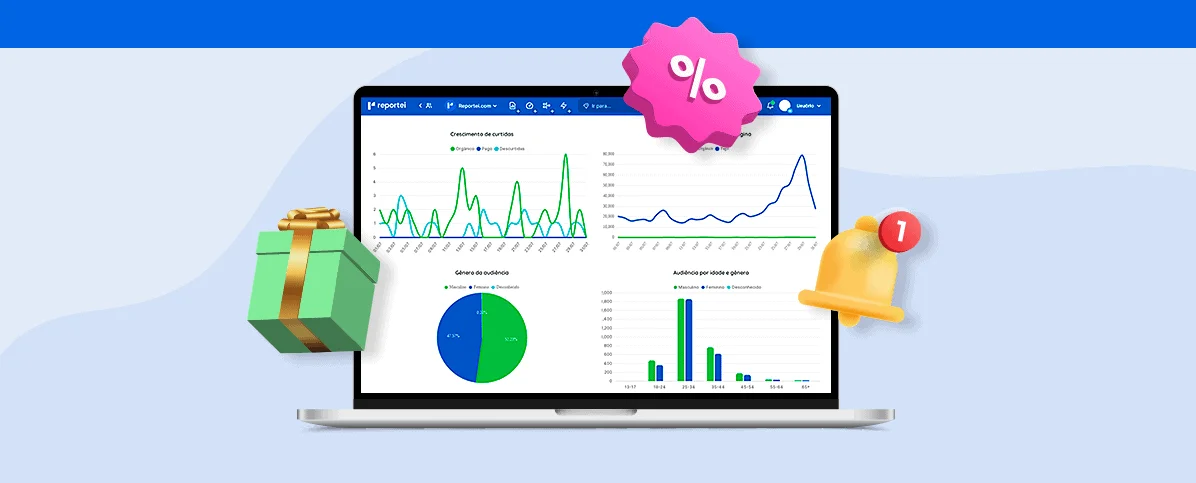Learn which data is essential to your Black Friday report and how to extract insights to prepare for next year
Black Friday is one of the most popular commercial dates worldwide, driving that sales boost for companies of all sectors.
For even more successful sales, most companies invest in digital marketing to reach more consumers and give their businesses a competitive advantage. From social media content to major ad campaigns, most consider digital presence a requirement for promoting sales deals and discounts towards making a profit come Black Friday.
But how can you measure your success (or that of clients) after Black Friday? How do you know whether the results were positive and if running future campaigns is worth the investment? To answer those questions, you’ll need to have a Black Friday report and use it to measure the efficiency of your actions, recording the data for future use.
We’ve put together this article with six fundamentals for analyzing your Black Friday data precisely and generating comprehensive reports for your decision-maker. Shall we get started?
6 tips for generating your Black Friday report in 2022
Whether you run ads for a day or the month of November, Black Friday is a one-off event that comes and goes quickly, which means campaigns must be precise.
Strategies must be constantly monitored and analyzed so you can take on any challenges that come your way and use that knowledge for future Black Friday campaigns. Check out 6 tips below on how to generate Black Friday reports effortlessly!
1. Monitor data in real-time
Besides generating a final report on your company’s or client’s Black Friday sales performance, real-time monitoring of your campaign data is crucial. That’s especially true if you’re running your campaigns for longer than the last Friday of the month.
Understanding your performance in content, ads, and relationship with your lead base helps you identify potential hurdles beforehand and redirect your strategies to get around them.
So, besides tracking results, it’s fundamental to have well-defined goals and indicators that act as a thermometer for measuring the success of your Black Friday activity.
2. List your most relevant metrics
And speaking of indicators, they should be based on the metrics most relevant to your business. With the ultimate goal of increasing revenue, sales data is the place to start. Some metrics are:
- Conversion rate (opportunities into sales);
- An average ticket within the period;
- Average discount during the period;
- Customer acquisition cost (CAC).
Besides that, the most significant metrics track the performance of your Black Friday 2022 campaigns, especially paid. Here’s some data to keep an eye on:
- Stipulated budget for each channel (ensuring you are sticking to it);
- Cost per click (CPC), which might be a bit higher than usual due to the highly competitive season;
- Cost per result.
3. Return on Investment
Another key metric for measuring your marketing and sales is ROAS (Return on Advertising Spend).
This data stands out from the rest because it has greater relevance to Black Friday reports. It helps determine whether your activities contributed to profit or loss. That’s because ROAS shows the relationship between revenue and spending over your Black Friday period.
Here’s how it’s calculated:
- ROAS: (Return from campaigns/ad costs) x 100
4. Compare Black Friday 2022 results with the results from previous years
If running Black Friday 2022 campaigns isn’t a first for your company or client, we recommend comparing results between this year and last in your report.
That helps you gauge the evolution of your campaigns, audience interaction with your content, and whether 2022 brought increased returns on investments.
5. Keep records to compare with next year
Don´t forget to compare your Black Friday results between this year and last. And it’s just as necessary to record your data this year to help with future promotional dates and events.
That’s a key tip to help you prepare for Digital Black Friday. It goes without saying that your records will help you set the best course for future strategies and make success likely.
6. Use a tool to help optimize your processes
With so much to keep track of during and following Black Friday, using a tool to help streamline your process is what you need to optimize your marketing team.
Reportei, for example, integrates with the most relevant digital marketing channels today. It automates your media metrics capture and helps you analyze your campaigns precisely.
Besides generating your Black Friday report in seconds, you can create custom templates to fit your client’s needs and dashboards for real-time monitoring.
And you can also take advantage of other exclusive features of our tool.
- Marketing Timeline: register campaigns, actions, and results and stay ahead of the game for next Black Friday!





